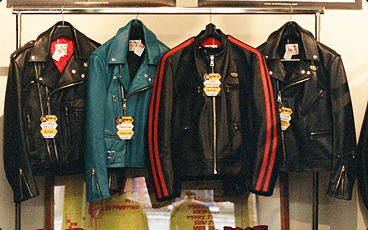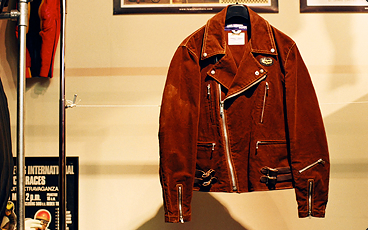History of Lewis Leathers Part1
Most important brand "Lewis Leathers" in history of British culture.
Derek Harris, the 5th generation owner, tells tradition and innovation.
10 4/14 UP
Text:Andrew Bunney Photo:Tommy Translation:Mayumi Horiguchi

Known for their distinctive motorbike jackets, Lewis Leathers is one of the UK’s
most enduring clothing companies - having survived wars, dramatic changes in
social history and the winds of fashion for nearly 120 years.
At its height in the 1970s, Lewis Leathers had six shops nationwide in Sheffield,
Birmingham and London. The stores offered boots, accessories and
made-to-measure leather jackets but by 1986 all had closed. Remaining as a
made-to-order business for many years, Lewis Leathers have recently opened a
new London shop close to the original address.
Family-owned until 1981 when the company changed hands, the helm eventually
fell to Derek Harris. Harris has been the owner of Lewis Leathers since 2003
although his involvement with the brand stretches back some 20 years.
Growing up with Punk as a teenager, Harris has seen and been involved with a
number of youth cults and London scenes. He was instrumental in introducing
a number of classic UK brands to Japan in the 1990s. Although his involvement
with Lewis Leathers started as a customer, his passion and obsession led him to
research the true company history, the products’ evolution and Lewis Leathers’
significance in UK motorcycling and fashion culture.
- Andrew Bunney(A)
- How did you become involved with Lewis Leathers?
- Derek Harris(D)
- I ended up going to Japan in June 1991, firstly to see some friends of mine that used to come over every six months. I was out there, and this band were touring, so I got a job translating for them, buying their food, lighting equipment and things. I stayed on longer, staying on friend’s floors, I hooked up with these guys that I knew, one of them had a company and said “We need someone to buy stuff for us in London. Would you do it?”
“Does that mean I’d be working for you?”
“Well, we can pay you a fee”. So I became a self-employed export agent, but I only worked for them, and I was just finding punk-y gear. One of the first things they wanted was leather jackets. So I said the first thing you want is Lewis Leathers, so I headed off there to take photographs of their jackets and things, and that’s how I first officially became involved. - A :
- You’d had the original point of contact with Lewis Leathers, what were the next developments there?
- D :
- The first thing we were looking at was that at that point the jackets didn’t look like the ones that were available in the ‘60s and ‘70s, which was the look we wanted to sell.
I sent the pictures to my pal Eiji that worked for the company who I had known since ‘85. We were both agreeing that these don’t look right, so I went back to Lewis Leathers and asked “can we change it?” and he said “they’re the same”. We tried a few things, but I hit upon the idea of going to Portobello Market(*1), getting a vintage Lightning jacket, took it to a tailor who re-cut the pattern and Lewis Leathers remade the jacket. Bingo, we had the jacket.
- A :
- Were they easy to find then?
- D :
- No-one wanted Lewis Leathers at that point. I got them for £10 or £15 each. There were other things – we needed to find the right buckles and linings, an evolving thing. Then we got the Bronx and a few more jackets and by the 3rd or 4th jacket I had a bit of a bug. I was really appreciating these things.
We got these styles up and running, and Richard Lyon who owned the business from 1986 decided to close the shop. It wasn’t doing well, high-overheads, and he could see that we were doing a couple of hundred a year in Japan, and if he closed the shop then maybe it could grow in profit again, albeit small profits. He had other companies that he was more than happily living from, meanwhile he let me get on with my thing.
I’d work until 8 o’clock with my day job, then go down to the factory because they’d be working all hours when they had work to do. I’d go down and make sure they had the collar right and stuff like that. 666(*2) were buying the jackets to sell in Japan, but what I was doing in the evening was purely my own thing. I’d come back home and it would be 11 o’clock, I was having great fun.

*1:Portobello Market …Blowout and lock fashion rider's jacket specialty store
*2:666 …Blowout and lock fashion rider's jacket specialty store
- A :
- And bit by bit you got involved further…?
- D :
-
I’d look into old motorcycle magazines from the ‘60s, find an old advert and take it into the shop and say “look at this” and it would say new jacket released when it was the Europa or whatever it model was, and they’d all burst out laughing in the shop saying “look at that stupid old advert”. But I was saying “This is important!” I thought they would all be going “Wow!” because none of them knew about the history of Lewis Leathers.
I was collecting anything I could find on Lewis Leathers at this point, I was finding more stuff out all the time, more catalogues and I was obsessed at this point. Going down to Portobello every morning, pick out different zippers to date it and I’d buy them for myself, and if I already had it I’d phone up my mate and ask if he wanted it because it was only 12 or 15 pounds. Some I would send to Japan, my friend Eiji was building up quite a collection because I was sending some out to him. We would correspond by fax saying ‘have you seen this detail?’ or ‘have you seen that?’ and it went on and on and on.
Sales were getting better; I was building up a nice historical archive of the company and really enjoying doing it because all that history had been forgotten. Richard thought it was great. I was just playing, but there seemed to be some purpose. In 2002 Junya Watanabe contacted Richard Lyon in view to doing a collaboration. So he called me up about it saying it was Comme Des Garcons, and I said that everyone speaks about the name with great reverence in Japan and they were the number one fashion house, so I said that you have to do this collaboration.

- It went very well. Even though there had been this underground of guys buying up vintage Lewis Leathers, this brought the name into a different market, high-end fashion. There was one more season, and then in 2003, Richard Lyon contacted me and told me he wanted to sell the company. He came to see me to talk to me about it and said, “Actually, I want you to buy it.” I took about 3 very large steps back, and said, “Okay, I’ll buy it, how much do you want?” He told me and I had absolutely no idea what I was supposed to do with it. I had never run a company before, but he said, “You are already doing it!”
I ended up buying Lewis Leathers and then realised I had payments to make every month. It’s a bit like getting married and getting a mortgage, you have to wise up quick.


